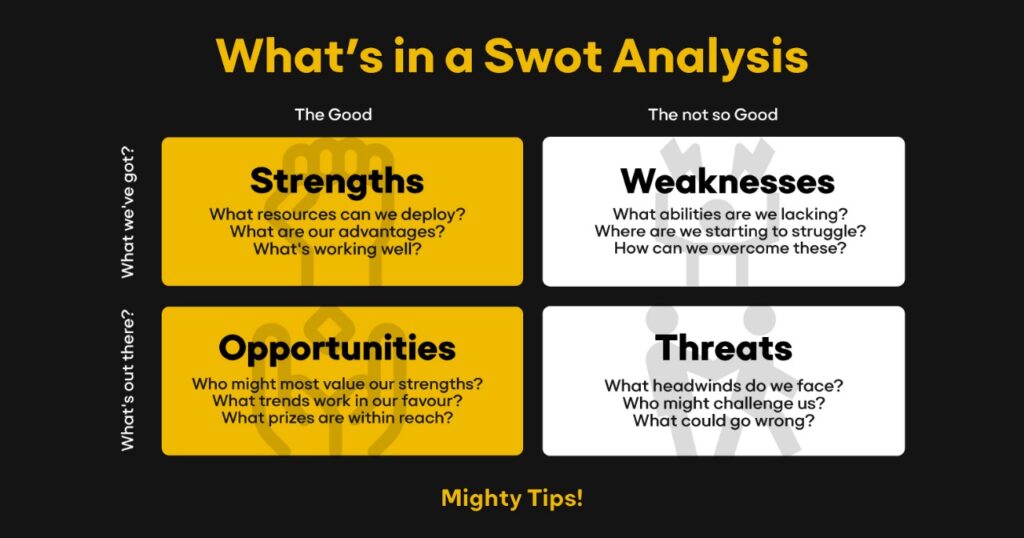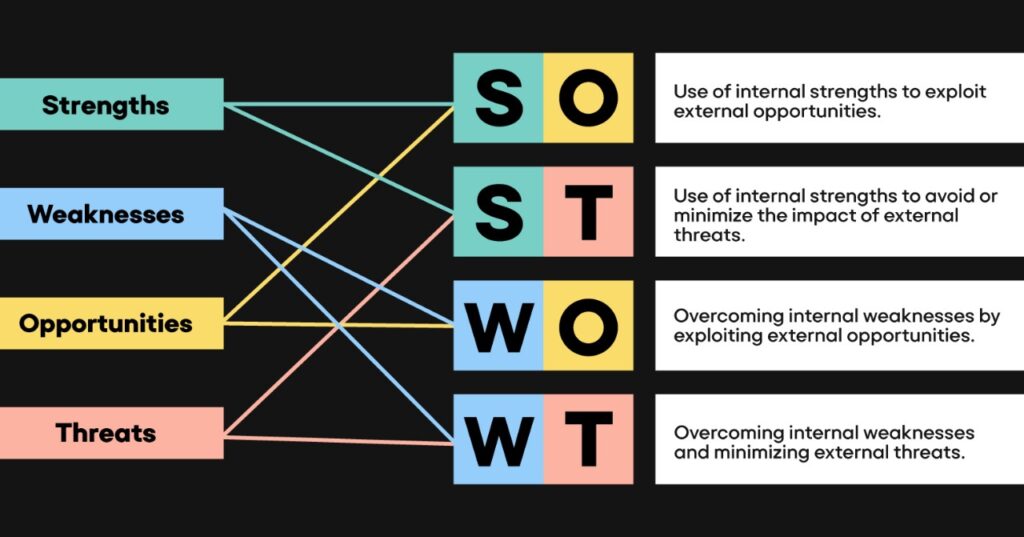Knowing your strengths, weaknesses, opportunities, and threats is crucial for success in the fast-paced business environment. A SWOT analysis can help with that. This effective tool helps you make well-informed decisions for expansion and improvement by giving you a comprehensive picture of your company’s present state.
What is a SWOT analysis, exactly?It’s a framework for assessing the external and internal elements affecting your company. Businesses may determine what is effective, what requires improvement, and where to direct their attention next by analyzing these factors.
For example, consider yourself in charge of a digital marketing firm. Your ability to create innovative advertising strategies may be your strongest suit, but you may find it difficult to keep up a consistent workflow during the off-season (weakness).
Simultaneously, the emergence of short-form video material offers intriguing new opportunities (opportunity), but there are also concerns (threats) due to growing competition from international organizations. These components are highlighted in a SWOT analysis to help you develop a more effective plan.
Why is SWOT Analysis Important?
In today’s competitive landscape, every business needs clarity and direction regardless of size. SWOT analysis acts as a guiding light, helping you:
- Align your efforts with your business goals.
- Anticipate and address challengeseffectively.
- Recognize untapped growth opportunities.
The concept of SWOT is familiar, but its value has only grown with time. Introduced in the 1960s by Albert Humphrey during a research project at Stanford University, it has become a cornerstone of strategic planning across industries.
By the end of this blog, you’ll have a complete understanding of what SWOT analysis is, how to conduct it, and how to use it to drive your business forward. Let’s get deeper into its components to discover its full potential.
What Does SWOT Stand For?

Strengths, Weaknesses, Opportunities, and Threats are referred to as SWOT. Each of these elements stands for an important aspect of your company and aids in assessing its overall standing. Let’s examine each component in further detail using real-world examples and analysis.
Strengths: Your Strongest Points
The internal qualities or assets that offer your company a competitive advantage are known as strengths. These are the strong points that set your brand apartfrom the competition.
For instance, it is a strength if your digital marketing business has a highly qualified staff in Search Engine Optimization (SEO). Similarly, having a solid track record of successful campaigns or having outstanding customer retention might be advantageous.
How to identify strengths:
- What aspects of your services are praised by your clients?
- Which procedures or instruments are effective and efficient?
- Do your rivals lack a unique selling proposition (USP) that you do?
Weaknesses: Areas for Improvement
The internal elements that limit the expansion or effectiveness of your company are known as weaknesses. These can be holes in your offers, inefficiencies, or resource constraints. Recognizing one’s shortcomings is the first step toward growth, not a sign of failure.
For instance, your firm could not have a diverse range of services or have trouble obtaining leads for high-value clients. Another potential vulnerability might be the use of increasingly sophisticated technologies by competitors.
How to identify weaknesses:
- Which client comments or complaints do you receive?
- Do you have ongoing difficulties in your business operations?
- Do you lack knowledge in a certain field?
Opportunities: Where Growth Awaits
Opportunities are outside forces that your company may take advantage of to expand or enhance. These can include unmet consumer wants, developing markets, or developments in your sector. Staying ahead of the curve is possible when you see opportunities.
For instance, your firm might take advantage of new advertising capabilities that social media sites introduce to provide customers with stronger campaigns. In a similar vein, the growing need for video creation services may be a profitable prospect.
How to identify opportunities:
- Are there market shifts or trends that you may profit from?
- Can you target underdeveloped customer segments?
- Which alliances or joint ventures could be advantageous to your company?
Threats: Challenges to Overcome
Threats are outside factors that have the potential to hurt your company. These might include shifts in consumer behavior, market rivalry, or economic downturns. Early danger detection allows you to develop plans to lessen their effects.
For example, low-cost rivals or emerging technology that renders conventional marketing strategies outdated might pose a danger to your business. Another risk can be a drop in the demand for particular services.
How to identify threats:
- What are the things that your competitors are doing better than you?
- Does your sector face any changes in the economy, politics, or regulations?
- Are your products becoming less popular with customers?
How to Conduct a SWOT Analysis Effectively?
Conducting a SWOT analysis requires a methodical and deliberate approach. You may make sure the procedure is enlightening and useful by following these steps. A detailed method to performing a successful SWOT analysis for your company can be found below.
Step 1: Establish Your Goal
Give a concise explanation of the purpose of your SWOT analysis first. What choice are you attempting to reach?
- Are you introducing a brand-new item or service?
- Does your marketing plan need to be improved?
- Are you attempting to enhance the general performance of your company?
For instance, your SWOT analysis would concentrate on strengths that can facilitate development, weaknesses that require attention, expansion chances, and threats from rivals if your objective is to increase the range of services offered by your organization.
Step 2: Gather a Diverse Team
Include team members from various departments or professions to obtain a well-rounded viewpoint. Working together guarantees that no important details are missed.
- Encourage leadership, project managers, designers, and marketers to participate.
- To precisely identify strengths and shortcomings, promote candid and open dialogue.
Advice:Get feedback from staff members through surveys or brainstorming sessions.
Step 3: Create a Four-Quadrant Grid
The analysis is kept clear and straightforward by using visual aids to organize it. Using the labels Strengths, Weaknesses, Opportunities, and Threats, divide a big page or digital document into four quadrants.
To organize your SWOT grid, you may use programs like Excel, Google Docs, or project management apps like Trello.
Step 4: Analyze Internal Factors (Strengths and Weaknesses)
Pay attention to your company’s strengths and areas for development.
- Strengths:Examine internal advantages such as special abilities, assets, or accomplishments. For instance: Our team’s proficiency in SEO regularly yields favorable outcomes for our clients.
- Weaknesses: Determine which regions need resources or exhibit performance delays. For instance: We lack experience in video production, despite the market’s increasing demand.
Advice:Maintain objectivity; admitting your shortcomings will enable you to overcome them.
Step 5: Assess External Factors (Opportunities and Threats)
To identify possible possibilities and risks, focus on the outside world.
- Opportunities:Find markets, trends, or technology that complement your company’s objectives. For instance: There is an opportunity to draw in small businesses due to the growing demand for local SEO services.
- Threats: Identify potential hazards like rivals or market saturation. For instance: Our manual methods may be surpassed by emerging AI-based marketing tools.
Advice:Use competition and market research to stay up to date on industry developments.
Step 6: Prioritize Your Findings
Not every threat, opportunity, weakness, or strength will have the same effect. Consider their importance and urgency while evaluating and ranking them.
- Pay attention to your strengths that complement your main objectives.
- Address any shortcomings that can impede development.
- Seize chances as soon as possible to obtain a competitive advantage.
- Reduce risks by mitigating dangers.
For instance, upskilling your staff should be your top priority if social media advertising has a high return on investment but you lack the necessary skills.
Step 7: Develop an Action Plan

Make a clear and workable plan using the information from your SWOT analysis.
- Make the most of possibilities by utilizing your talents.
- Reducing vulnerabilities requires addressing flaws.
- Make backup plans in case of emergencies.
For instance, you can look into joint ventures with video experts while educating your internal staff if your forte is producing captivating content but your weakness is a lack of skills in video creation.
Step 8: Regularly Update Your SWOT Analysis
Your company environment is always changing, therefore it’s critical to frequently review your SWOT analysis. This guarantees that your tactics will always be applicable and successful.
- Plan a review for each quarter or following notable market developments.
- Revise conclusions in light of fresh information, customer comments, or market trends.
Tip:SWOT analysis is a dynamic document that changes as your company does.
Your SWOT analysis will become an effective tool for strategic planning and well-informed decision-making if you follow these procedures.
Example of SWOT Analysis in Action
Examining actual cases of how companies employ SWOT analysis to inform their strategy and spur expansion can help you completely understand the tool’s worth. Here are some instances from various sectors that show how effective SWOT analysis can be.
A Digital Marketing Agency
Consider a digital marketing firm that provides services like web design, social media marketing, and SEO. The agency might apply a SWOT analysis as follows:
Strengths:
- Experienced Staff:The firm employs knowledgeable experts in social media and SEO who consistently provide positive outcomes for customers.
- Strong Client Relationships:Developed connections with important clients who consistently bring in business.
- Reputation for Results: Well-known for providing quantifiable return on investment (ROI) for marketing initiatives, which fosters customer loyalty and confidence.
Weaknesses:
- Limited Video Production Services:The firm does not have in-house video production skills, despite the demand for video marketing.
- Narrow Market Focus: Its potential for large-scale initiatives is limited because it mostly serves small-to-medium firms.
Opportunities:
- Growing Video Marketing Market:As video material becomes more popular, there is a chance to broaden their portfolio and provide video creation services.
- Growing Need for Local SEO Services:The need for local SEO services is growing as more small companies want to get their name out there.
- Trend in Remote Work: The agency may reach a larger clientele of international clients since remote work facilitates cross-border collaboration.
Threats:
- Growing Competition in SEO Services:Market share is at risk from new digital marketing firms who provide affordable rates.
- Algorithm Changes:SEO tactics may be impacted by changes to search engine algorithms, necessitating ongoing adaptation on the part of the firm.
Action Plan:
- Invest in improving the team’s video production skills to satisfy consumer demand.
- Investigate joint ventures with video production firms to provide a whole package.
- Expand the service offering to include local SEO and target larger companies for higher-value contracts.
- Keep up SEO developments to stay ahead of the competition and adjust to algorithm modifications.
Utilizing Your SWOT Analysis for Actionable Insights

The next stage after finishing a SWOT analysis is to use the knowledge you’ve gained to motivate action. A SWOT analysis is a strategic tool that should direct the creation of projects, impact decision-making, and efficiently coordinate your resources.
It is not a one-time activity. Here’s how to turn your SWOT analysis into useful informationthat will support the expansion of your company.
1. Build on Your Strengths
The things that set you apart from the competition and provide you a competitive edge are your strengths. Think about how you can improve on your strengths to get the most out of them.
Action Steps:
- Emphasize Your Key Marketing Strengths:In your marketing initiatives, highlight your strengths as unique selling points (USPs). For instance, if your company has a talented staff or a solid track record of producing outcomes, be sure that these attributes are highlighted in case studies, client endorsements, and advertising.
- Develop Your Core Skills:Think about how you can broaden your skills if you have certain talents. For instance, if SEO is your digital marketing agency’s strong suit, think about developing sophisticated SEO packages, providing specialized content production, or doing SEO audits to draw in bigger clients.
- Make the Most of Client Relationships:Take advantage of any solid client relationships you may have. You may promote loyalty programs, recommendations, and repeat business. Additionally, think about giving devoted clients early access to new features or goods or exclusive services.
Example:
A digital marketing agency may enhance its reputation for effective SEO and attract companies seeking to further improve their online presence.
2. Address Your Weaknesses
Finding strategies to reduce or get rid of the vulnerabilities in your SWOT analysis is the next stage. Improving your business’s overall success requires addressing your deficiencies. Ignoring them could prevent your company from realizing its full potential.
Action Steps:
- Invest in Training and Resources:If you have gaps in your team’s knowledge or skills, such as a lack of expertise in a certain area, invest in upskilling them or recruiting professionals to cover them. For example, if your agency is deficient in video production, think about employing freelance video editors or educating your current staff.
- Maximize Operational Efficiency:Operations flaws, such as antiquated systems or ineffective procedures, might impede expansion. To cut down on inefficiencies and streamline procedures, spend money on automation tools or software.
- Outsource or Collaborate with Experts:If fixing a weakness calls for knowledge you don’t currently possess, think about outsourcing or collaborating with experts. For instance, to expand its product line, a software development business may collaborate with a cybersecurity company.
Example:
A clothes business with a small online presence can overcome this shortcoming by using an e-commerce platform or improving the SEO of its website. Sales may rise as a result, and the clientele may grow beyond local consumers.
3. Capitalize on Opportunities
Opportunities are outside forces that can help you expand or enhance your company. You may develop a plan for growing and maintaining your competitiveness by recognizing these possibilities.
Action Steps:
- Create New Goods or Services:Take advantage of each chance to broaden your product or service offerings. For example, if there is increasing demand in the industry, a digital marketing firm may introduce a new service such as paid advertising management.
- Reach Out to New Client Segments or Markets:Investigate unexplored markets. This might entail reaching out to a new consumer base, changing your target demographic, or growing geographically. For instance, you may branch out into providing solutions for larger firms if your company specializes in software development for small businesses.
- Benefit from Industry Trends:Keep up with changes and developments in the industry. For instance, there may be an increase in demand for remote team management software or virtual communication tools as companies move more and more toward remote work. You may take advantage of these possibilities by creating goods or services that complement these trends.
Example:
A software business might take advantage of the rising demand for cloud-based solutions and provide consumers quicker access to its services by shifting part of its products to a Software-as-a-Service (SaaS) model.
4. Mitigate Threats
Threats are outside variables that might have a detrimental effect on your company. To lessen the effect of these dangers, proactive mitigation is crucial.
Action Steps:
- Monitor the Competitive Landscape:Keep an eye on the competitive environment by learning about the market and your rivals. Evaluate rivals’ price, marketing, and move tactics on a regular basis. Watch for new rivals and be ready to adjust.
- Diversify Your Sources of Income:Dependence on a single product, service, or customer may expose you to changes in the market. Spread out the risk by diversifying your sources of income. To reach a wider audience and lessen their need on in-person sales, a retail establishment can, for instance, open an online store.
- Prepare for Uncertainty in the Economy: Economic downturns and shifts in customer behavior are beyond your control, but you may plan for them. Make backup plans, cut back on wasteful spending, and develop adaptable company models that can change with the times.
- Keep Up to Date with Industry Changes:New rules, algorithms, or platforms can have a big impact on how IT and marketing companies operate. Invest in your team’s ongoing education, read industry blogs, and attend webinars to stay updated.
Example:
By focusing on a niche market and providing services that target particular industries or demographics, such e-commerce companies or healthcare providers, a digital marketing agency may lessen the danger of growing competition.
5. Monitor and Adjust Regularly
SWOT analysis should be reviewed on a regular basis; it is not a one-time task. What can be a strength now could turn into a problem tomorrow since the business climate is always changing. To stay on course, establish a procedure for routinely reviewing and modifying your plan.
Action Steps:
- Plan Frequent SWOT Reviews:To keep up with shifts in the market, technology, and consumer tastes, think about performing a SWOT analysis every three or six months.
- Modify Plans in Light of New Information:Utilize the results of your SWOT analysis to keep improving your tactics. Make the necessary adjustments to your marketing campaigns, product development, or operational procedures as new opportunities arise or threats grow in importance.
- Continue to Communicate with Stakeholders:To acquire fresh insights on your advantages, disadvantages, opportunities, and risks, solicit input from partners, clients, and staff.
Your company may optimize the advantages of your SWOT analysis and use it as a potent instrument for development, competitive advantage, and sustainability by putting these doable measures into practice.
Conclusion – The Power of SWOT Analysis in Business Strategy

Sustainable growth and success in today’s cutthroat business environment depend on having a thorough awareness of your company’s internal strengths and weaknesses as well as external possibilities and dangers.
An effective SWOT analysis gives you a thorough understanding of your company. SWOT analysis is an essential technique that should be ingrained in your company culture if you want to keep a competitive advantage.
It’s a continuous process that aids in the growth, adaptation, and response of your company to both internal and external influences, not merely a strategic exercise.
Your team will be more equipped to predict problems, make data-driven choices, and match your company’s objectives with the state of the market if you regularly do a SWOT analysis. Therefore, make sure that a SWOT analysis is at the center of your strategy whether you’re introducing a new product, breaking into a new market, or organizing for the upcoming quarter.
